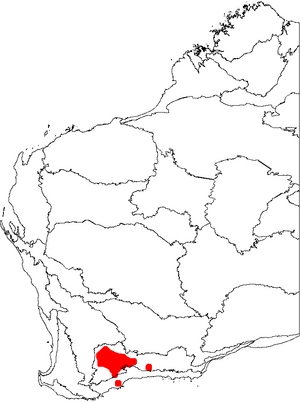Banksia xylothemelia facts for kids
Quick facts for kids Banksia xylothemelia |
|
|---|---|
| Scientific classification | |
| Genus: |
Banksia
|
| Species: |
xylothemelia
|
| Synonyms | |
|
Dryandra xylothemelia A.S.George |
|
Banksia xylothemelia is a special kind of shrub that grows low to the ground. It belongs to the Proteaceae plant family. You can only find it in southern Western Australia. People often call it a dryandra, and its old name was Dryandra xylothemelia. It's not very common to see this plant growing in gardens.
Contents
What Does Banksia xylothemelia Look Like?
This plant is a low-growing shrub, usually about 1 meter (3 feet) tall. It often has new shoots that grow from a special underground stem called a lignotuber. Its stems feel soft and woolly.
Its leaves are long, about 7 to 12 cm (3 to 5 inches) long and 4 to 5.5 cm (1.5 to 2 inches) wide. They have 5 to 9 small parts on each side, like a feather. The top of the leaves is smooth, but the bottom is woolly.
The flowers grow in round, dome-shaped clusters, about 4 cm (1.5 inches) wide. These clusters are attached right to an older stem or on a short stalk. Each flower cluster has about 80 to 100 bright yellow flowers. Each flower has a tube-shaped part and a long, thin, hooked style (the part that helps with reproduction). The styles are first tucked inside the flower, but they pop out when the flower opens. After flowering, seeds grow inside woody pods that are part of the flower head.
How Was Banksia xylothemelia Named?
Scientists started collecting Banksia xylothemelia specimens in the 1990s. For example, Robert M. Buehrig found one in the Dragon Rocks Nature Reserve in 1993. Another was found near Lake King by P. G. Wilson.
On October 11, 1994, a scientist named Alex George collected a plant that became the "type specimen." This is the main example used to describe a new species. He found it on Holt Rock South Road, about 14 km (9 miles) north of Newdigate-Lake King Road.
Two years later, Alex George officially described the species in a science journal called Nuytsia. He first put it in a group called Dryandra. He gave it the name "xylothemelia." This name comes from two Greek words: "xylon" meaning wood and "themelios" meaning foundation. This name refers to the plant's special underground lignotuber. This lignotuber helps tell it apart from a similar plant, B. cirsioides. So, for a while, its full name was Dryandra xylothemelia A.S.George.
In 2007, two other scientists, Austin Mast and Kevin Thiele, moved all the Dryandra plants into the Banksia group. So, the current name for this plant is Banksia xylothemelia (A.S.George) A.R.Mast & K.R.Thiele.
Where Does Banksia xylothemelia Grow?
This plant grows in sandy soil over laterite (a type of reddish soil) or in gravelly loam. You can find it in heathlands or sometimes in mallee woodlands and shrublands. It only grows in two specific areas of Western Australia: the Esperance Plains and Mallee regions. These areas are between places like Kulin, Lake Magenta, Frank Hann National Park, and Hyden.
How Does Banksia xylothemelia Survive?
Like many other plants in the Proteaceae family, Banksia xylothemelia has special roots called proteoid roots. These roots have many tiny clusters of rootlets that form a mat just under the leaf litter. These special roots help the plant take in nutrients from poor soils, especially soils that don't have much phosphorus.
Because it has a lignotuber (that underground stem), this plant can grow back after a bushfire burns the parts above ground.
The plant is listed as "Priority Three - Poorly Known Taxa" by Western Australia's Department of Environment and Conservation. This means scientists don't know a lot about it, but it's not immediately endangered.
Scientists have studied how climate change might affect this plant. They found that its natural home range could shrink by half if the climate changes a little. If the climate changes a lot, the plant might even disappear unless it can quickly move to new areas where it can survive.
Can You Grow Banksia xylothemelia in a Garden?
Banksia xylothemelia is not often grown in gardens. It prefers lateritic soils and other heavy soils. Once it's established, it can handle dry conditions and some frost. Experts Tony Cavanagh and Margaret Pieroni suggest it would be best for a small garden in a warm, sunny spot.
Its seeds can take six to seven weeks to sprout. However, not many seeds usually grow into plants. Most reports say that less than 30% of the seeds successfully germinate.


